Poole Ch.P., Jr. Handbook of Superconductivity
Подождите немного. Документ загружается.

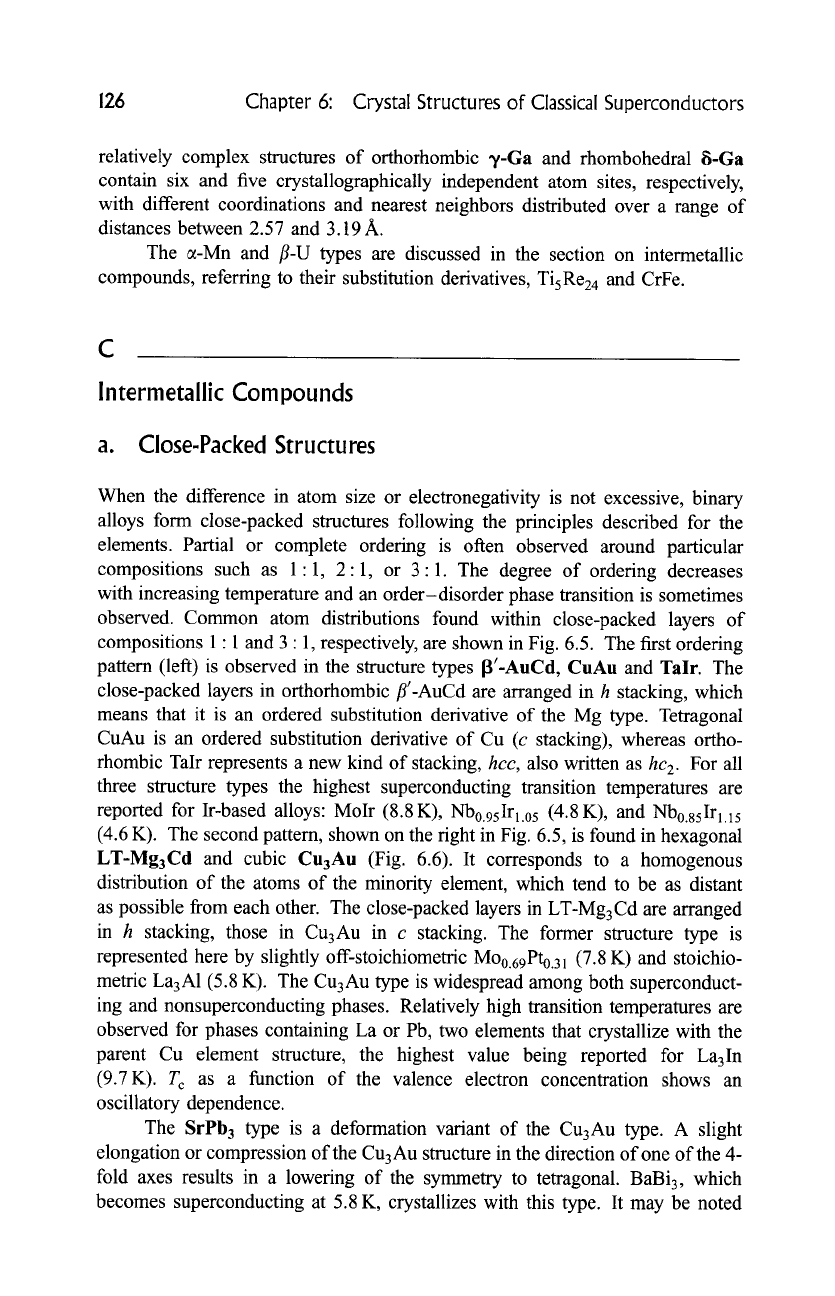
126
Chapter 6: Crystal Structures of Classical Superconductors
relatively complex structures of orthorhombic ~/-Ga and rhombohedral ~i-Ga
contain six and five crystallographically independent atom sites, respectively,
with different coordinations and nearest neighbors distributed over a range of
distances between 2.57 and 3.19 A.
The ~-Mn and fl-U types are discussed in the section on intermetallic
compounds, referring to their substitution derivatives, TisRe24 and CrFe.
C
lntermetallic Compounds
a. Close-Packed Structures
When the difference in atom size or electronegativity is not excessive, binary
alloys form close-packed structures following the principles described for the
elements. Partial or complete ordering is often observed around particular
compositions such as 1:1, 2:1, or 3:1. The degree of ordering decreases
with increasing temperature and an order-disorder phase transition is sometimes
observed. Common atom distributions found within close-packed layers of
compositions 1 : 1 and 3 : 1, respectively, are shown in Fig. 6.5. The first ordering
pattern (left) is observed in the structure types 13'-AuCd, CuAu and Talr. The
close-packed layers in orthorhombic fl'-AuCd are arranged in h stacking, which
means that it is an ordered substitution derivative of the Mg type. Tetragonal
CuAu is an ordered substitution derivative of Cu (c stacking), whereas ortho-
rhombic Talr represents a new kind of stacking,
hcc,
also written as
hc2.
For all
three structure types the highest superconducting transition temperatures are
reported for Ir-based alloys: Molr (8.8 K), Nb0.95Irl.05 (4.8 K), and Nb0.85Ir1.15
(4.6 K). The second pattern, shown on the fight in Fig. 6.5, is found in hexagonal
LT-Mg3Cd and cubic Cu3Au (Fig. 6.6). It corresponds to a homogenous
distribution of the atoms of the minority element, which tend to be as distant
as possible from each other. The close-packed layers in LT-Mg 3 Cd are arranged
in h stacking, those in Cu3Au in c stacking. The former structure type is
represented here by slightly off-stoichiometric Mo0.69Pt0.31 (7.8 K) and stoichio-
metric La3A1 (5.8 K). The Cu3Au type is widespread among both superconduct-
ing and nonsuperconducting phases. Relatively high transition temperatures are
observed for phases containing La or Pb, two elements that crystallize with the
parent Cu element structure, the highest value being reported for La3In
(9.7K). T c as a function of the valence electron concentration shows an
oscillatory dependence.
The SrPb 3 type is a deformation variant of the Cu3Au type. A slight
elongation or compression of the Cu3Au structure in the direction of one of the 4-
fold axes results in a lowering of the symmetry to tetragonal. BaBi3, which
becomes superconducting at 5.8 K, crystallizes with this type. It may be noted
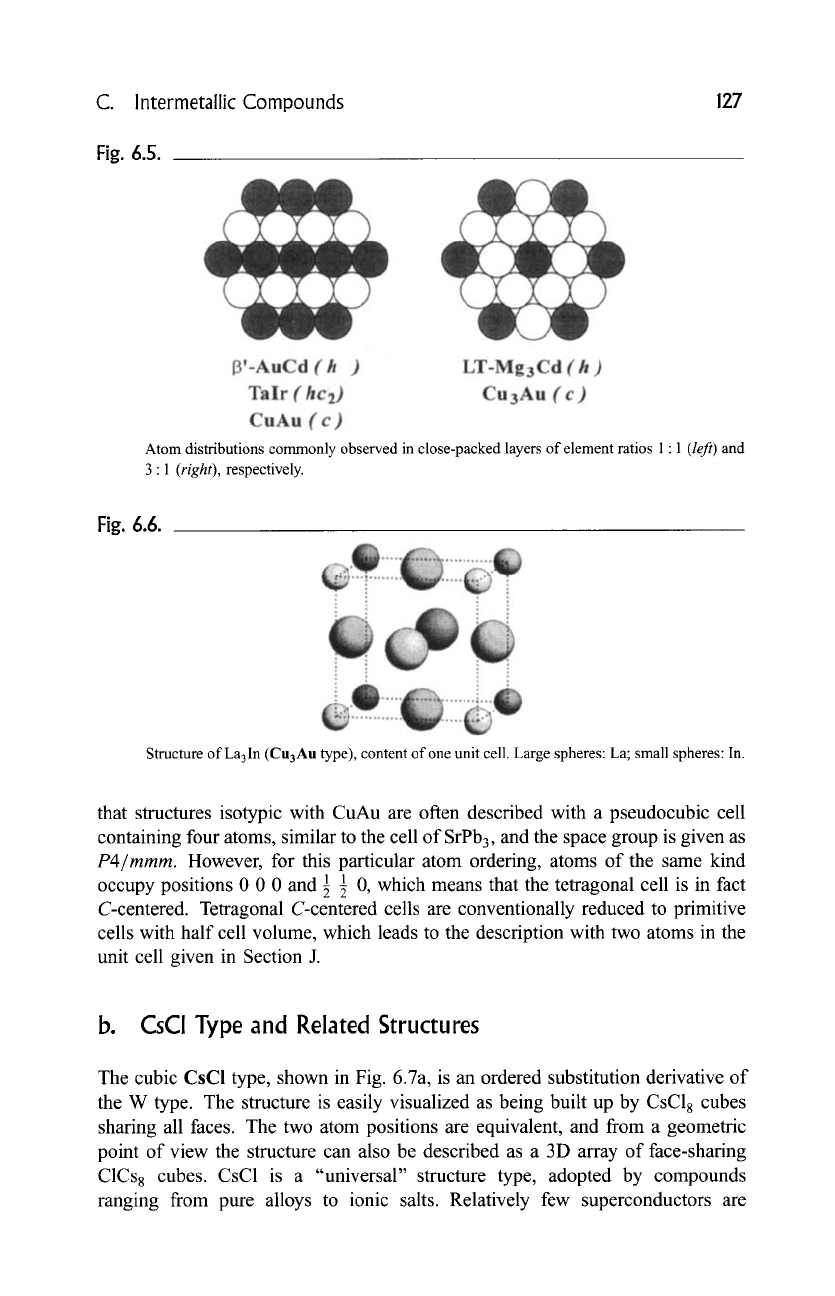
C. lntermetallic Compounds 127
Fig. 6.5.
Atom distributions commonly observed in close-packed layers of element ratios 1 : 1
(left)
and
3:1
(right),
respectively.
Fig. 6.6.
Structure ofLa3In (Cu3Au type), content of one unit cell. Large spheres: La; small spheres: In.
that structures isotypic with CuAu are often described with a pseudocubic cell
containing four atoms, similar to the cell of SrPb 3, and the space group is given as
P4/mmm.
However, for this particular atom ordering, atoms of the same kind
occupy positions 0 0 0 and 89 89 0, which means that the tetragonal cell is in fact
C-centered. Tetragonal C-centered cells are conventionally reduced to primitive
cells with half cell volume, which leads to the description with two atoms in the
unit cell given in Section J.
b. CsCI Type and Related Structures
The cubic CsCI type, shown in Fig. 6.7a, is an ordered substitution derivative of
the W type. The structure is easily visualized as being built up by CsC18 cubes
sharing all faces. The two atom positions are equivalent, and from a geometric
point of view the structure can also be described as a 3D array of face-sharing
C1Cs 8 cubes. CsC1 is a "universal" structure type, adopted by compounds
ranging from pure alloys to ionic salts. Relatively few superconductors are
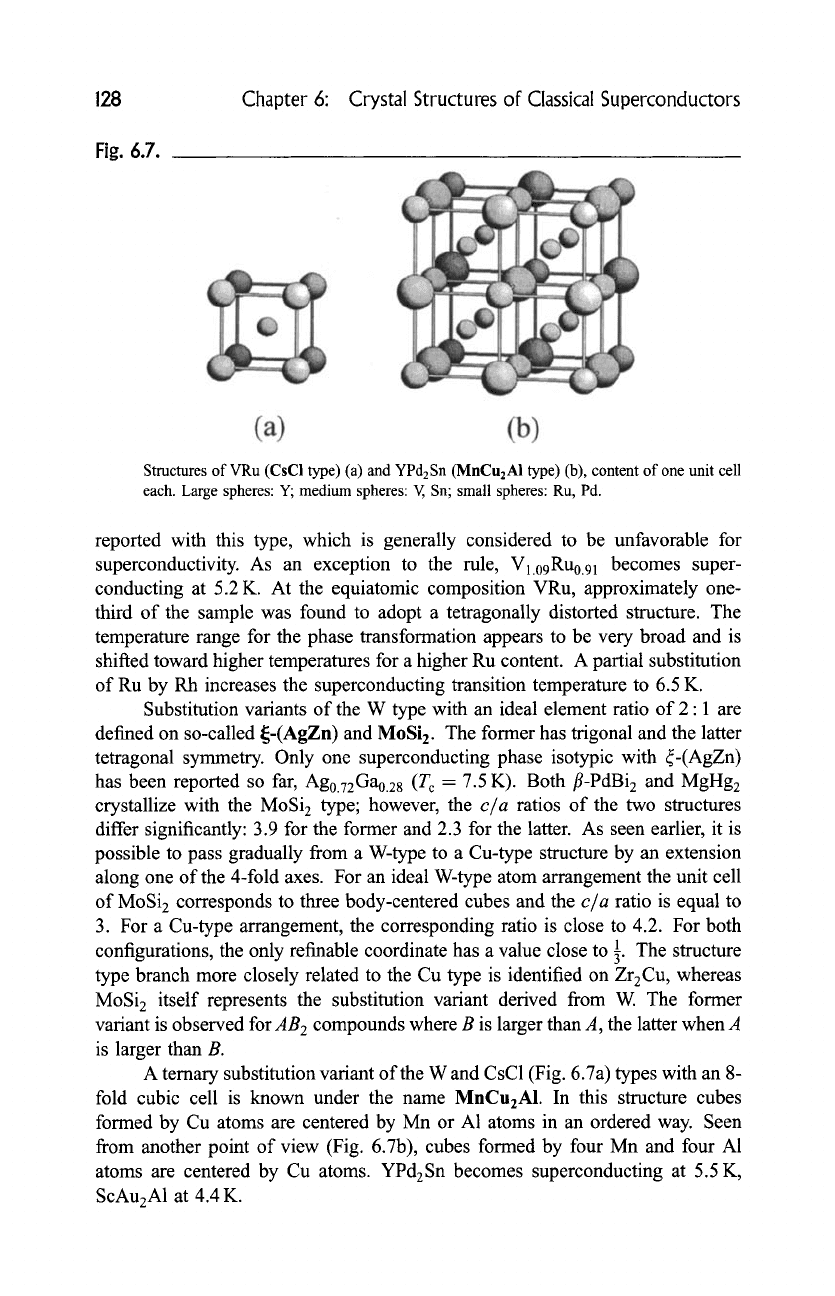
128 Chapter 6: Crystal Structures of Classical Superconductors
Fig. 6.7.
Structures of VRu (CsCI type) (a) and YPd2Sn (MnCu2AI type) (b), content of one unit cell
each. Large spheres: Y; medium spheres: V, Sn; small spheres: Ru, Pd.
reported with this type, which is generally considered to be unfavorable for
superconductivity. As an exception to the rule,
V1.09Ru0.91
becomes super-
conducting at 5.2 K. At the equiatomic composition VRu, approximately one-
third of the sample was found to adopt a tetragonally distorted structure. The
temperature range for the phase transformation appears to be very broad and is
shifted toward higher temperatures for a higher Ru content. A partial substitution
of Ru by Rh increases the superconducting transition temperature to 6.5 K.
Substitution variants of the W type with an ideal element ratio of 2:1 are
defined on so-called ~-(AgZn) and MoSi 2. The former has trigonal and the latter
tetragonal symmetry. Only one superconducting phase isotypic with ~-(AgZn)
has been reported so far, Ag0.72Ga0.28 (T c = 7.5 K). Both fl-PdBi 2 and MgHg 2
crystallize with the MoSi 2 type; however, the
c/a
ratios of the two structures
differ significantly: 3.9 for the former and 2.3 for the latter. As seen earlier, it is
possible to pass gradually from a W-type to a Cu-type structure by an extension
along one of the 4-fold axes. For an ideal W-type atom arrangement the unit cell
of MoSi 2 corresponds to three body-centered cubes and the
c/a
ratio is equal to
3. For a Cu-type arrangement, the corresponding ratio is close to 4.2. For both
configurations, the only refinable coordinate has a value close to 89 The structure
type branch more closely related to the Cu type is identified on Zr2Cu, whereas
MoSi 2 itself represents the substitution variant derived from W. The former
variant is observed for
AB E
compounds where B is larger than A, the latter when A
is larger than B.
A ternary substitution variant of the W and CsC1 (Fig. 6.7a) types with an 8-
fold cubic cell is known under the name MnCu2Al. In this structure cubes
formed by Cu atoms are centered by Mn or A1 atoms in an ordered way. Seen
from another point of view (Fig. 6.7b), cubes formed by four Mn and four A1
atoms are centered by Cu atoms. YPd2Sn becomes superconducting at 5.5 K,
ScAu2A1 at 4.4 K.
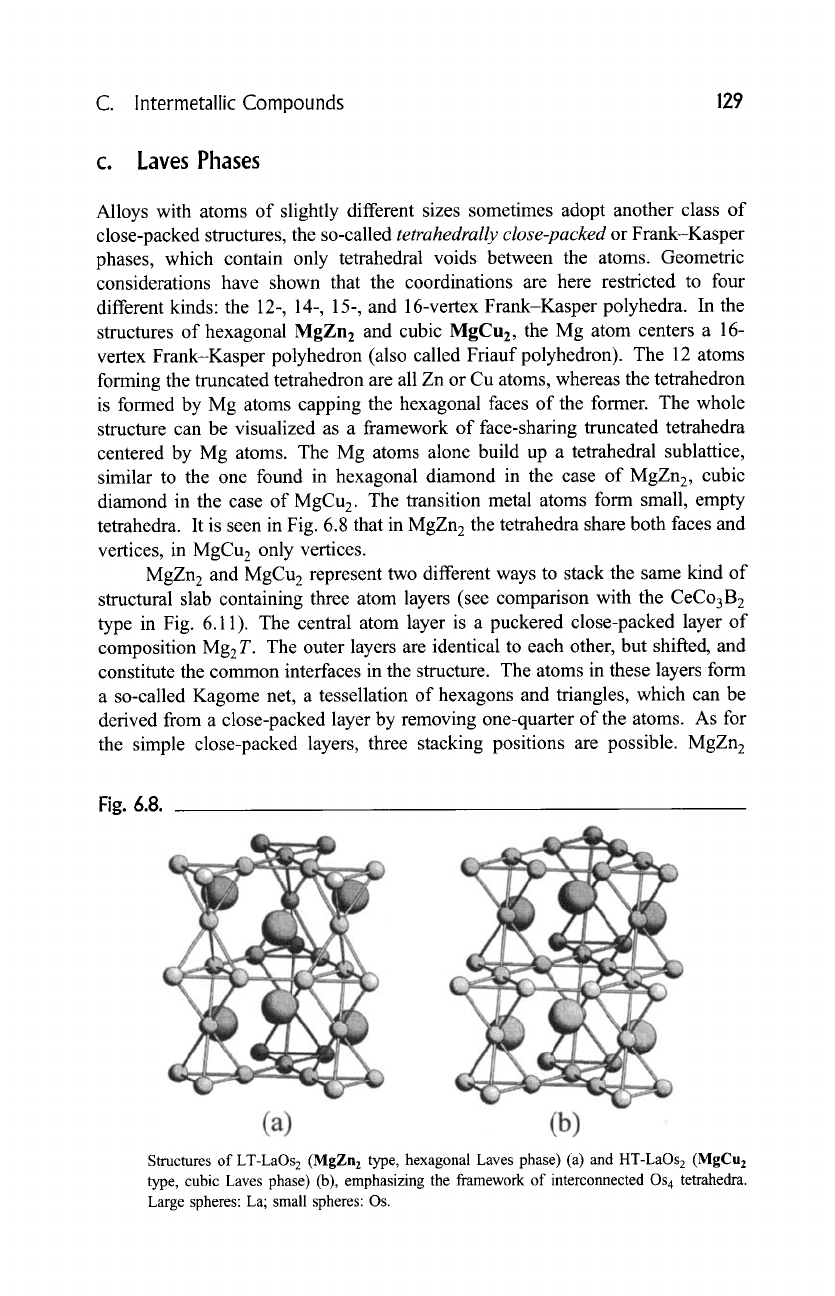
C. Intermetallic Compounds 129
c. Laves Phases
Alloys with atoms of slightly different sizes sometimes adopt another class of
close-packed structures, the so-called
tetrahedrally close-packed
or Frank-Kasper
phases, which contain only tetrahedral voids between the atoms. Geometric
considerations have shown that the coordinations are here restricted to four
different kinds: the 12-, 14-, 15-, and 16-vertex Frank-Kasper polyhedra. In the
structures of hexagonal MgZn 2 and cubic MgCu 2, the Mg atom centers a 16-
vertex Frank-Kasper polyhedron (also called Friauf polyhedron). The 12 atoms
forming the truncated tetrahedron are all Zn or Cu atoms, whereas the tetrahedron
is formed by Mg atoms capping the hexagonal faces of the former. The whole
structure can be visualized as a framework of face-sharing truncated tetrahedra
centered by Mg atoms. The Mg atoms alone build up a tetrahedral sublattice,
similar to the one found in hexagonal diamond in the case of MgZn 2, cubic
diamond in the case of MgCu 2. The transition metal atoms form small, empty
tetrahedra. It is seen in Fig. 6.8 that in MgZn 2 the tetrahedra share both faces and
vertices, in MgCu 2 only vertices.
MgZn 2 and MgCu 2 represent two different ways to stack the same kind of
structural slab containing three atom layers (see comparison with the CeCo3B 2
type in Fig. 6.11). The central atom layer is a puckered close-packed layer of
composition Mg 2 T. The outer layers are identical to each other, but shifted, and
constitute the common interfaces in the structure. The atoms in these layers form
a so-called Kagome net, a tessellation of hexagons and triangles, which can be
derived from a close-packed layer by removing one-quarter of the atoms. As for
the simple close-packed layers, three stacking positions are possible. MgZn 2
Fig. 6.8.
Structures of LT-LaOs 2 (MgZn 2 type, hexagonal Laves phase) (a) and HT-LaOs 2 (MgCu 2
type, cubic Laves phase) (b), emphasizing the framework of interconnected Os 4 tetrahedra.
Large spheres: La; small spheres: Os.
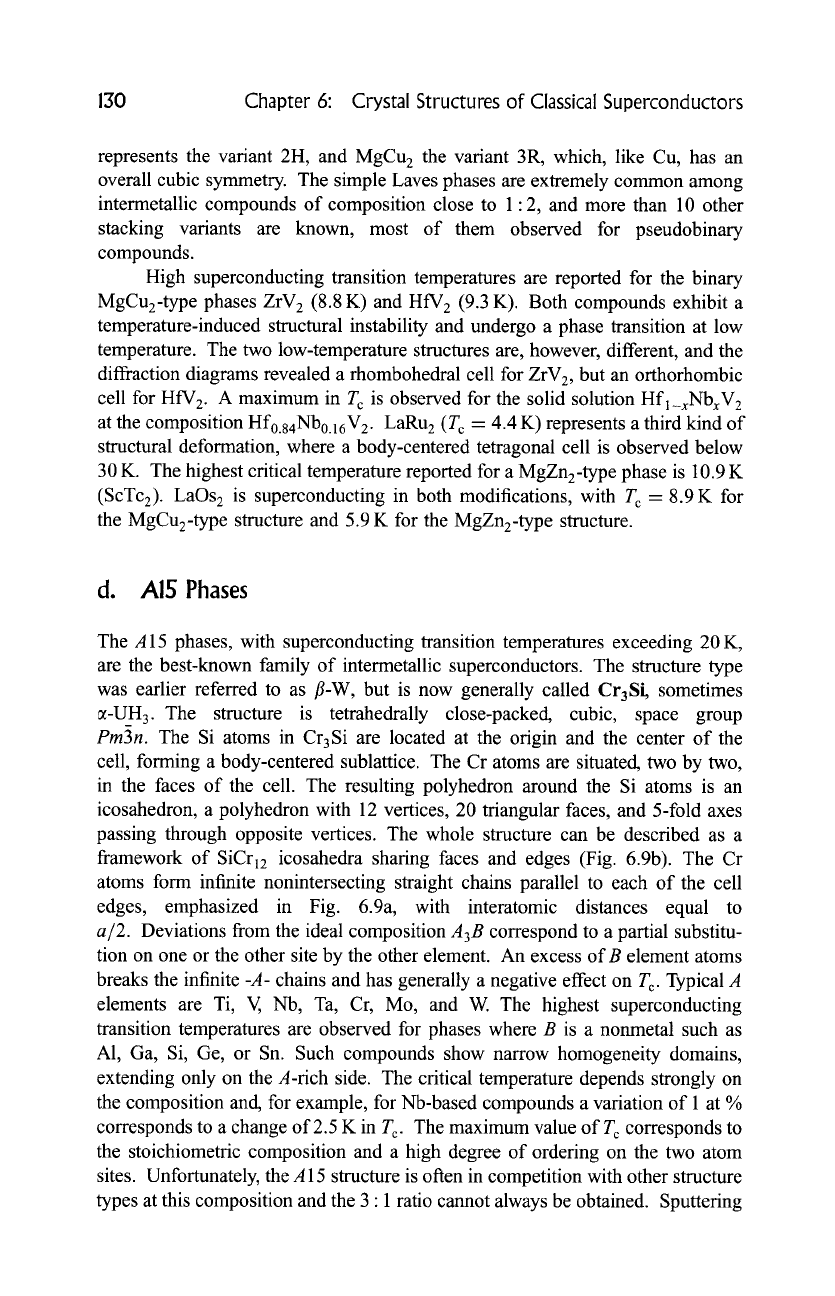
130
Chapter 6: Crystal Structures of Classical Superconductors
represents the variant 2H, and MgCu 2 the variant 3R, which, like Cu, has an
overall cubic symmetry. The simple Laves phases are extremely common among
intermetallic compounds of composition close to 1:2, and more than 10 other
stacking variants are known, most of them observed for pseudobinary
compounds.
High superconducting transition temperatures are reported for the binary
MgCuz-type phases ZrV 2 (8.8 K) and HfV 2 (9.3 K). Both compounds exhibit a
temperature-induced structural instability and undergo a phase transition at low
temperature. The two low-temperature structures are, however, different, and the
diffraction diagrams revealed a rhombohedral cell for ZrV2, but an orthorhombic
cell for HfV 2. A maximum in T c is observed for the solid solution Hfl_xNbxV 2
at the composition Hf0.s4Nb0.16V 2. LaRu 2 (T c = 4.4 K) represents a third kind of
structural deformation, where a body-centered tetragonal cell is observed below
30 K. The highest critical temperature reported for a MgZnz-type phase is 10.9 K
(ScTc2). LaOs2 is superconducting in both modifications, with T c = 8.9 K for
the MgCuz-type structure and 5.9 K for the MgZnz-type structure.
d. A15 Phases
The A 15 phases, with superconducting transition temperatures exceeding 20 K,
are the best-known family of intermetallic superconductors. The structure type
was earlier referred to as fl-W, but is now generally called Cr3Si, sometimes
~-UH 3. The structure is tetrahedrally close-packed, cubic, space group
Pm3n.
The Si atoms in Cr3Si are located at the origin and the center of the
cell, forming a body-centered sublattice. The Cr atoms are situated, two by two,
in the faces of the cell. The resulting polyhedron around the Si atoms is an
icosahedron, a polyhedron with 12 vertices, 20 triangular faces, and 5-fold axes
passing through opposite vertices. The whole structure can be described as a
framework of SiCr12 icosahedra sharing faces and edges (Fig. 6.9b). The Cr
atoms form infinite nonintersecting straight chains parallel to each of the cell
edges, emphasized in Fig. 6.9a, with interatomic distances equal to
a/2.
Deviations from the ideal composition
A3B
correspond to a partial substitu-
tion on one or the other site by the other element. An excess of B element atoms
breaks the infinite -A- chains and has generally a negative effect on T c. Typical A
elements are Ti, V, Nb, Ta, Cr, Mo, and W. The highest superconducting
transition temperatures are observed for phases where B is a nonmetal such as
A1, Ga, Si, Ge, or Sn. Such compounds show narrow homogeneity domains,
extending only on the A-rich side. The critical temperature depends strongly on
the composition and, for example, for Nb-based compounds a variation of 1 at %
corresponds to a change of 2.5 K in T c. The maximum value of T c corresponds to
the stoichiometric composition and a high degree of ordering on the two atom
sites. Unfortunately, the A 15 structure is often in competition with other structure
types at this composition and the 3 : 1 ratio cannot always be obtained. Sputtering
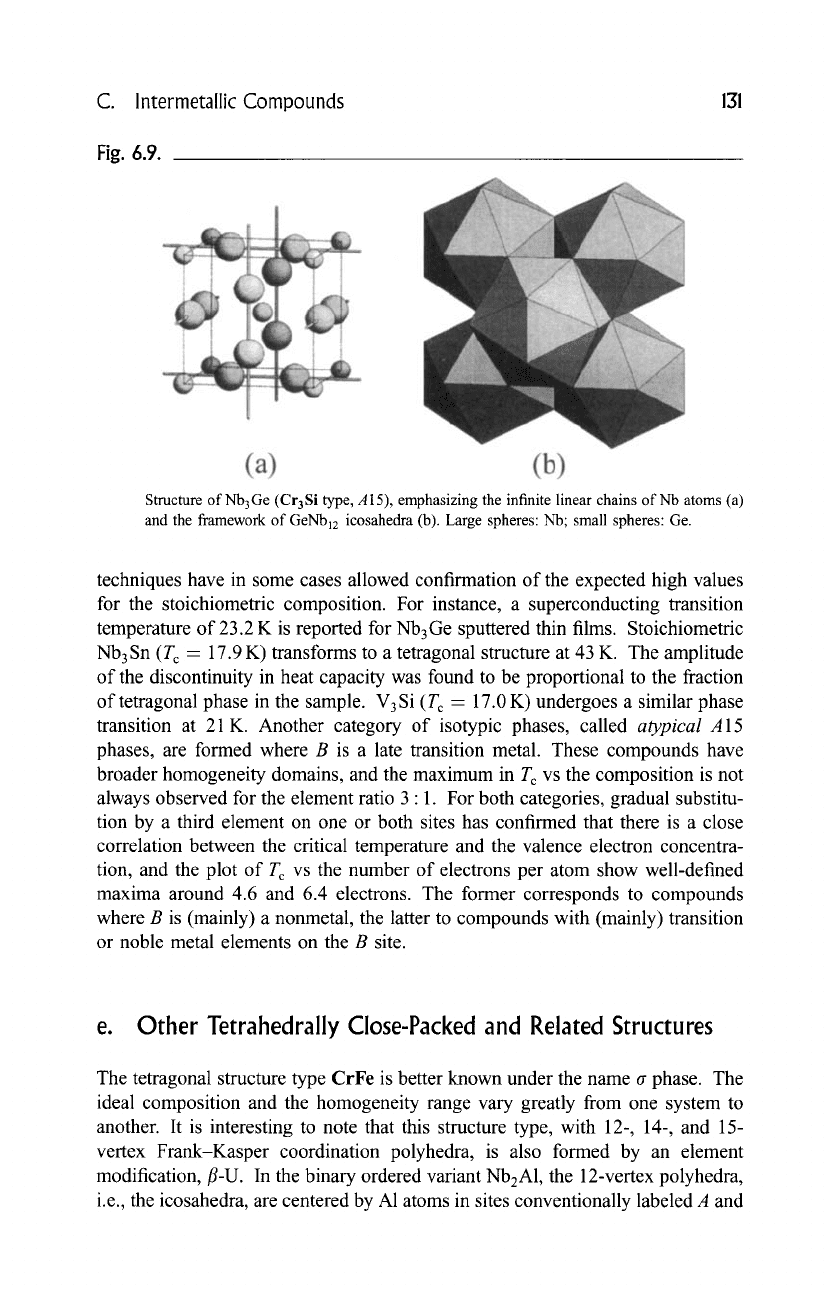
C. lntermetallic Compounds 131
Fig.
6.9.
Structure of Nb3Ge (Cr3Si type, A15), emphasizing the infinite linear chains of Nb atoms (a)
and the framework of
GeNb12
icosahedra (b). Large spheres: Nb; small spheres: Ge.
techniques have in some cases allowed confirmation of the expected high values
for the stoichiometric composition. For instance, a superconducting transition
temperature of 23.2 K is reported for Nb 3 Ge sputtered thin films. Stoichiometric
Nb3Sn (T c - 17.9 K) transforms to a tetragonal structure at 43 K. The amplitude
of the discontinuity in heat capacity was found to be proportional to the fraction
of tetragonal phase in the sample. V3Si (T c -- 17.0 K) undergoes a similar phase
transition at 21 K. Another category of isotypic phases, called
atypical
A15
phases, are formed where B is a late transition metal. These compounds have
broader homogeneity domains, and the maximum in T c vs the composition is not
always observed for the element ratio 3 : 1. For both categories, gradual substitu-
tion by a third element on one or both sites has confirmed that there is a close
correlation between the critical temperature and the valence electron concentra-
tion, and the plot of T c vs the number of electrons per atom show well-defined
maxima around 4.6 and 6.4 electrons. The former corresponds to compounds
where B is (mainly) a nonmetal, the latter to compounds with (mainly) transition
or noble metal elements on the B site.
e. Other Tetrahedrally Close-Packed and Related Structures
The tetragonal structure type CrFe is better known under the name a phase. The
ideal composition and the homogeneity range vary greatly from one system to
another. It is interesting to note that this structure type, with 12-, 14-, and 15-
vertex Frank-Kasper coordination polyhedra, is also formed by an element
modification,/~-U. In the binary ordered variant NbzA1, the 12-vertex polyhedra,
i.e., the icosahedra, are centered by A1 atoms in sites conventionally labeled A and
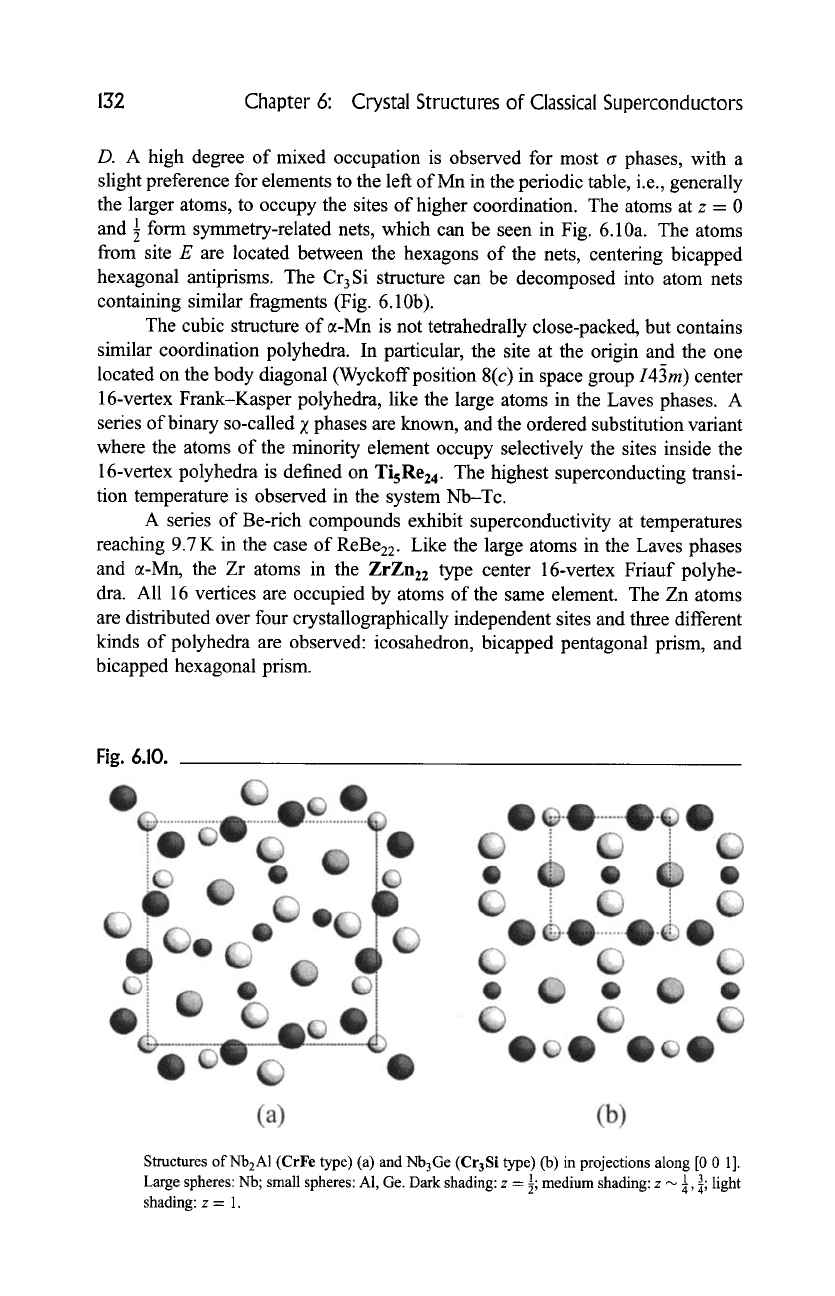
132
Chapter 6: Crystal Structures of Classical Superconductors
D. A high degree of mixed occupation is observed for most tr phases, with a
slight preference for elements to the left of Mn in the periodic table, i.e., generally
the larger atoms, to occupy the sites of higher coordination. The atoms at z = 0
and 1 form symmetry-related nets, which can be seen in Fig. 6.10a. The atoms
from site E are located between the hexagons of the nets, centering bicapped
hexagonal antiprisms. The Cr3Si structure can be decomposed into atom nets
containing similar fragments (Fig. 6.10b).
The cubic structure of ~-Mn is not tetrahedrally close-packed, but contains
similar coordination polyhedra. In particular, the site at the origin and the one
located on the body diagonal (Wyckoff position 8(c) in space group
I43m)
center
16-vertex Frank-Kasper polyhedra, like the large atoms in the Laves phases. A
series of binary so-called Z phases are known, and the ordered substitution variant
where the atoms of the minority element occupy selectively the sites inside the
16-vertex polyhedra is defined on TisRe24. The highest superconducting transi-
tion temperature is observed in the system Nb-Tc.
A series of Be-rich compounds exhibit superconductivity at temperatures
reaching 9.7 K in the case of ReBe22. Like the large atoms in the Laves phases
and ~-Mn, the Zr atoms in the ZrZn22 type center 16-vertex Friauf polyhe-
dra. All 16 vertices are occupied by atoms of the same element. The Zn atoms
are distributed over four crystallographically independent sites and three different
kinds of polyhedra are observed: icosahedron, bicapped pentagonal prism, and
bicapped hexagonal prism.
Fig. 6.10.
Structures ofNb2A1 (CrFe type) (a) and Nb3Ge (CraSi type) (b) in projections along [0 0 1].
Large spheres: Nb; small spheres: A1, Ge. Dark shading: z = 89 medium shading: z ~ 88 light
shading: z = 1.
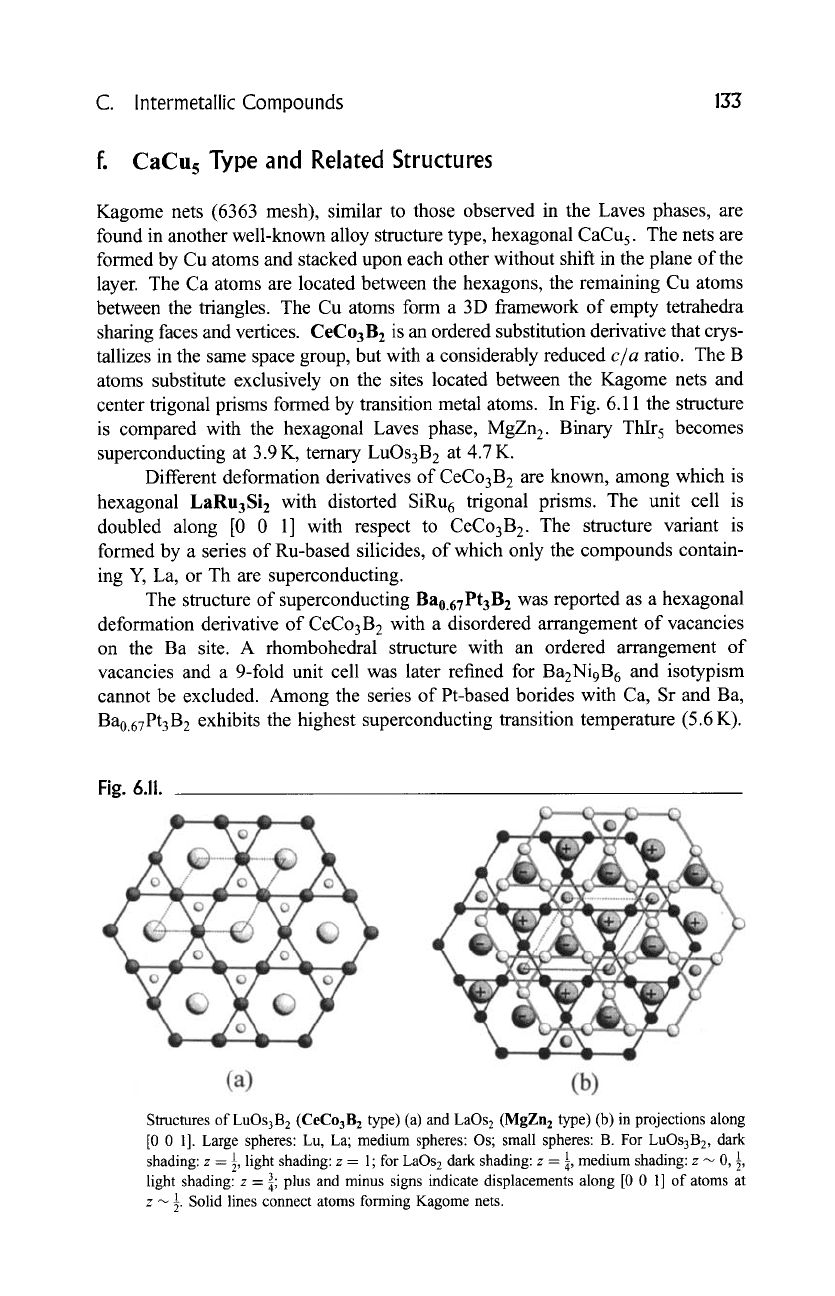
C. lntermetallic Compounds 133
f. CaCus Type and Related Structures
Kagome nets (6363 mesh), similar to those observed in the Laves phases, are
found in another well-known alloy structure type, hexagonal CaCu 5. The nets are
formed by Cu atoms and stacked upon each other without shift in the plane of the
layer. The Ca atoms are located between the hexagons, the remaining Cu atoms
between the triangles. The Cu atoms form a 3D framework of empty tetrahedra
sharing faces and vertices. CeCo3B 2 is an ordered substitution derivative that crys-
tallizes in the same space group, but with a considerably reduced
c/a
ratio. The B
atoms substitute exclusively on the sites located between the Kagome nets and
center trigonal prisms formed by transition metal atoms. In Fig. 6.11 the structure
is compared with the hexagonal Laves phase, MgZn 2. Binary ThIr 5 becomes
superconducting at 3.9 K, ternary LuOs3B 2 at 4.7 K.
Different deformation derivatives of CeCo3B 2 are known, among which is
hexagonal LaRu3Si 2 with distorted SiRu 6 trigonal prisms. The unit cell is
doubled along [0 0 1] with respect to CeCo3B 2. The structure variant is
formed by a series of Ru-based silicides, of which only the compounds contain-
ing Y, La, or Th are superconducting.
The structure of superconducting Bao.67Pt3B2 was reported as a hexagonal
deformation derivative of CeCoaB 2 with a disordered arrangement of vacancies
on the Ba site. A rhombohedral structure with an ordered arrangement of
vacancies and a 9-fold unit cell was later refined for Ba2Ni9B 6 and isotypism
cannot be excluded. Among the series of Pt-based borides with Ca, Sr and Ba,
Bao.67PtaB2 exhibits the highest superconducting transition temperature (5.6 K).
Fig. 6.11.
Structures of LuOs3B 2 (CeCo3B 2 type) (a) and LaOs 2 (MgZn 2 type) (b) in projections along
[0 0 1]. Large spheres: Lu, La; medium spheres: Os; small spheres: B. For LuOsaB2, dark
shading: z = 89 light shading: z = 1; for LaOs 2 dark shading: z = J, medium shading: z ~ 0,1,
light shading: z- 3; plus and minus signs indicate displacements along [0 0 1] of atoms at
z ~ 1. Solid lines connect atoms forming Kagome nets.
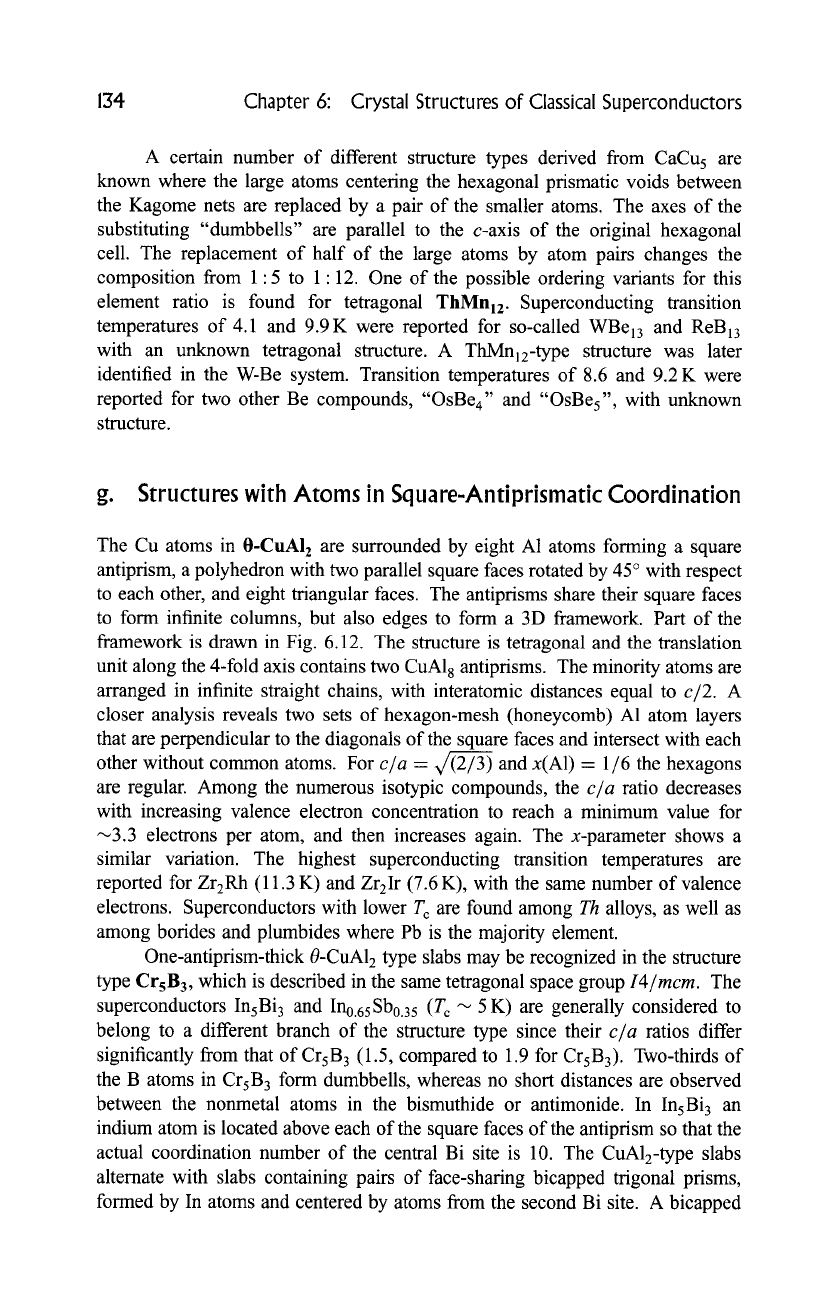
134
Chapter 6: Crystal Structures of Classical Superconductors
A certain number of different structure types derived from CaCu5 are
known where the large atoms centering the hexagonal prismatic voids between
the Kagome nets are replaced by a pair of the smaller atoms. The axes of the
substituting "dumbbells" are parallel to the c-axis of the original hexagonal
cell. The replacement of half of the large atoms by atom pairs changes the
composition from 1:5 to 1:12. One of the possible ordering variants for this
element ratio is found for tetragonal ThMnl2. Superconducting transition
temperatures of 4.1 and 9.9K were reported for so-called WBel3 and ReB13
with an unknown tetragonal structure. A ThMn12-type structure was later
identified in the W-Be system. Transition temperatures of 8.6 and 9.2 K were
reported for two other Be compounds, "OsBe4" and "OsBes", with unknown
structure.
g. Structures with Atoms in Square-Antiprismatic Coordination
The Cu atoms in 0-CuAI 2 are surrounded by eight A1 atoms forming a square
antiprism, a polyhedron with two parallel square faces rotated by 45 ~ with respect
to each other, and eight triangular faces. The antiprisms share their square faces
to form infinite columns, but also edges to form a 3D framework. Part of the
framework is drawn in Fig. 6.12. The structure is tetragonal and the translation
unit along the 4-fold axis contains two CuA18 antiprisms. The minority atoms are
arranged in infinite straight chains, with interatomic distances equal to
c/2. A
closer analysis reveals two sets of hexagon-mesh (honeycomb) A1 atom layers
that are perpendicular to the diagonals of the square faces and intersect with each
other without common atoms. For
c/a
= v/(2/3) and x(A1) -- 1/6 the hexagons
are regular. Among the numerous isotypic compounds, the
c/a
ratio decreases
with increasing valence electron concentration to reach a minimum value for
~3.3 electrons per atom, and then increases again. The x-parameter shows a
similar variation. The highest superconducting transition temperatures are
reported for ZrzRh (11.3 K) and ZrzIr (7.6 K), with the same number of valence
electrons. Superconductors with lower T c are found among
Th
alloys, as well as
among borides and plumbides where Pb is the majority element.
One-antiprism-thick 0-CuA12 type slabs may be recognized in the structure
type CrsB3, which is described in the same tetragonal space group
I4/mcm.
The
superconductors InsBi 3 and In0.65Sb0.35 (T c ~ 5 K) are generally considered to
belong to a different branch of the structure type since their
c/a
ratios differ
significantly from that of CrsB 3 (1.5, compared to 1.9 for CrsB3). Two-thirds of
the B atoms in CrsB 3 form dumbbells, whereas no short distances are observed
between the nonmetal atoms in the bismuthide or antimonide. In InsBi 3 an
indium atom is located above each of the square faces of the antiprism so that the
actual coordination number of the central Bi site is 10. The CuAlz-type slabs
alternate with slabs containing pairs of face-sharing bicapped trigonal prisms,
formed by In atoms and centered by atoms from the second Bi site. A bicapped
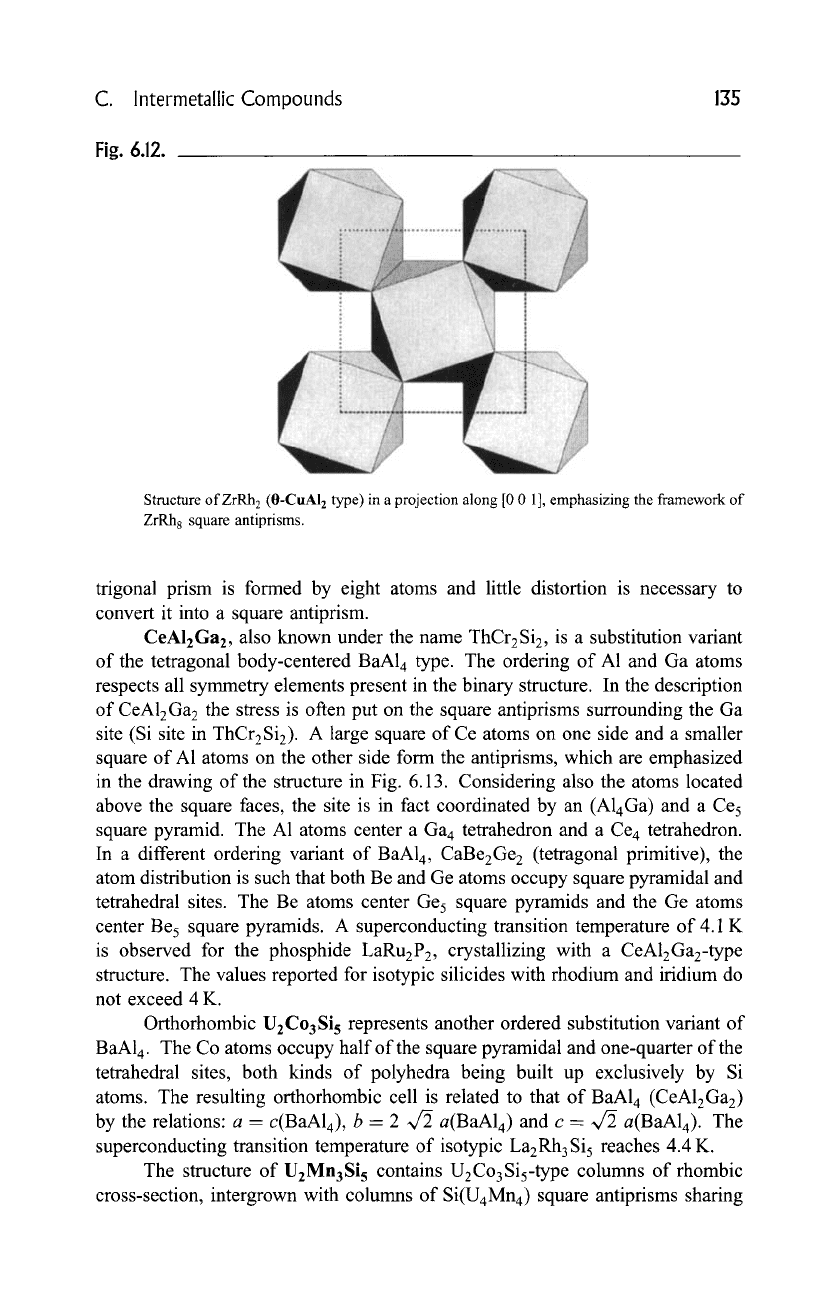
C. Intermetallic Compounds
13S
Fig. 6.12.
Structure of
ZrRh 2 (0-CuAI 2
type) in a projection along [0 0 1], emphasizing the framework of
ZrRh 8 square antiprisms.
trigonal prism is formed by eight atoms and little distortion is necessary to
convert it into a square antiprism.
CeAI2Ga2, also known under the name ThCrzSi2, is a substitution variant
of the tetragonal body-centered BaA14 type. The ordering of A1 and Ga atoms
respects all symmetry elements present in the binary structure. In the description
of CeAlzGa 2 the stress is often put on the square antiprisms surrounding the Ga
site (Si site in ThCr2Si2). A large square of Ce atoms on one side and a smaller
square of A1 atoms on the other side form the antiprisms, which are emphasized
in the drawing of the structure in Fig. 6.13. Considering also the atoms located
above the square faces, the site is in fact coordinated by an (A14Ga) and a Ce 5
square pyramid. The A1 atoms center a Ga4 tetrahedron and a Ce 4 tetrahedron.
In a different ordering variant of BaA14, CaBezGe 2 (tetragonal primitive), the
atom distribution is such that both Be and Ge atoms occupy square pyramidal and
tetrahedral sites. The Be atoms center Ge 5 square pyramids and the Ge atoms
center Be 5 square pyramids. A superconducting transition temperature of 4.1 K
is observed for the phosphide LaRuzP 2, crystallizing with a CeAlzGaz-type
structure. The values reported for isotypic silicides with rhodium and iridium do
not exceed 4 K.
Orthorhombic UzC03Si s represents another ordered substitution variant of
BaA14. The Co atoms occupy half of the square pyramidal and one-quarter of the
tetrahedral sites, both kinds of polyhedra being built up exclusively by Si
atoms. The resulting orthorhombic cell is related to that of BaA14 (CeAlzGa2)
by the relations: a - c(BaA14), b - 2 ~ a(BaA14) and c- ~ a(BaA14). The
superconducting transition temperature of isotypic LazRh3Si 5 reaches 4.4 K.
The structure of U2Mn3Si s contains U2Co3Sis-type columns of rhombic
cross-section, intergrown with columns of Si(U4Mn4) square antiprisms sharing
